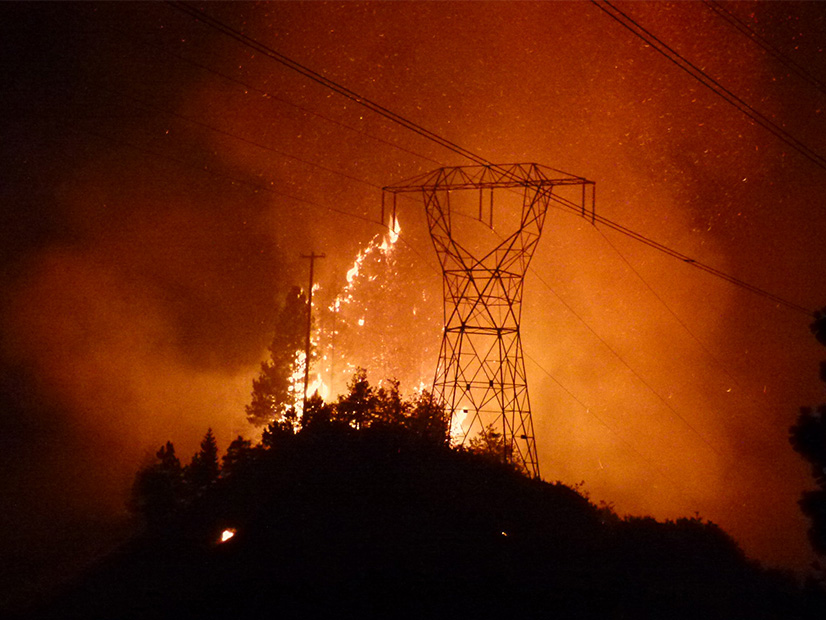
Extreme weather, wildfires and supply-chain problems could continue to make CAISO vulnerable to energy shortfalls and outages starting this summer, despite ongoing efforts to increase reliability, speakers said Friday at a workshop hosted by the California Energy Commission (CEC) and the California Public Utilities Commission.
The CPUC has ordered nearly 15 GW of new supply to come online through 2026, but delayed battery production and stalled shipments of solar panels from Southeast Asia could undermine those efforts, speakers said.
At the same time, CAISO faces the challenge of trying to interconnect an unprecedented number of renewable resources in a relatively short time, as the state transitions from fossil fuels to clean energy.
“With a tremendous amount of new resources needed to be brought online in California, and some of the headwinds confronting us on supply chain issues and other significant risk variables, it is essential that our processes for onboarding new resources be up to the task,” CAISO COO Mark Rothleder said, reading from a written statement by CEO Elliot Mainzer, who could not attend the workshop.
The ISO added 3,698 MW of installed capacity to its grid in 2021 and is on track to add 3,062 MW more by July 1, much of it as battery storage, Neil Millar, vice president of infrastructure and operations planning, said.
CAISO has begun connecting resources, such as solar and storage, in geographically grouped superclusters of dozens of units, and is currently involved in a stakeholder initiative to streamline and triage its “overheated” interconnection queue of nearly 246,000 applicants, Millar said.
Adding to those challenges, CEC planners said a combination of heat, drought, fire and supply chain disruptions could result in California’s energy supply falling far short of demand over the next four summers.
Previous examples include a California heat wave last July that coincided with a major wildfire in southern Oregon. The Bootleg Fire nearly shut down the Pacific AC and DC interties, the main transmission links between the Pacific Northwest and California. As hydropower stopped flowing to California, CAISO declared energy emergencies but did not need to order rolling blackouts, as it did in August 2020, when a severe Western heat wave shrank imports into California.
In even more extreme scenarios, cumulative disruptions from weather and fire could leave the state 7,000 MW short this summer and up to 10,000 MW short by 2025, David Erne, manager of CEC’s Supply Analysis Office, said.
The gap could be as little 1,700 MW this summer and 1,800 MW in 2025, without cumulative crises, he said.
The state is adopting measures to make up the differences including temporary generation, delayed plant retirements, increased generator efficiency and expanded demand response programs, but all those efforts could be insufficient, Erne said.
Solar, Battery Delays
Gov. Gavin Newsom’s budget proposal, updated earlier this month, proposes a $5.2 billion, 5,000-MW “strategic electric reliability reserve” to meet the challenges of extreme heat, wildfires, drought and the West’s changing resource mix. (See Calif. Governor Proposes $5B ‘Reliability Reserve’.)
Newsom said that greater dangers from wildfires, heat and drought prompted the need, which could be met with new generation and storage, backup generation and other methods. Record-low reservoir levels in California and the Southwest are expected to severely limit hydropower production this summer.
The governor has floated the idea of keeping the state’s last nuclear generator, PG&E’s Diablo Canyon Power Plant, operating beyond its planned retirement in 2024-25. Advocates for keeping Diablo Canyon open have argued the plant’s retirement will exacerbate resource deficiencies.
As in the past two summers, the main reliability challenge in CAISO will continue to be the 7-9 p.m. summer net peak, when solar ramps down but demand remains high because of high heat and air conditioning use, analysts said.
CAISO has interconnected 4,000 MW of four-hour lithium-ion battery storage since the August 2020 outages to help cover the net peak, but future storage additions could be hampered by pandemic lockdowns in China and rising lithium costs, Molly Sterkel, program manager at the CPUC’s Energy Division, said.
“While these shutdowns appear to be resolved at the present moment, developers are now furiously calculating their revised delivery dates for batteries and the impact that has on their construction schedule,” Sterkel said.
The U.S. Commerce Department is investigating allegations that Southeast Asian solar panel manufacturers are using Chinese components but circumventing U.S. tariffs on Chinese goods.
“This has led to the severe disruption on the supply of solar panels into the U.S. market,” Sterkel said. “Some of the solar projects that were expected for 2022 are far enough along that they have not been directly impacted by this petition” but future projects could be delayed, she said.
